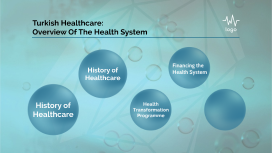Healthcare Management
Transcript: Turkish Healthcare: Overview Of The Health System Financing the Health System The healthcare system in Turkey has a highly complex structure. The Ministry of Health (MOH), universities and the private sector are the health service providers in the Turkish health system. History of Healthcare The Turkish MOH was initially established in 1920. The foundations of the current Turkish public health system were built in the period between 1923 and 1946. The Social Insurance Organisation called “Sosyal Sigortalar Kurumu” or “SSK” was created to provide health insurance to privatesector and blue collar public-sector employees. History of Healthcare In 1950, the “Emekli Sandığı” was established to serve the white-collar workers. The General Health Insurance (GSS) system was introduced in 1963. It was later reintroduced in the National Health Policy (1990). However, government changes could not be implemented due to economic crises. Between 1986 and 1989 the government adopted the Program Law as a temporary solution until the Initiation of Health Insurance through Bag-Kur (Social Insurance Institution for Traders, Craftsmen and Self-Employed). Then, in 1992, the Green Card program was established to provide free healthcare to poor and uninsured people. As of the end of 2007, approximately 9 million citizens benefited from the Green Card system. In 2003, the Health Transformation Program (SDP) was accepted by the Ministry of Health between 2003 and 2013. As of 2008, the harmonization of the benefits package was completed and finally GSS united all the insured. Health Transformation Programme Health Transformation Programme After the HTP was put into practice, family medicine practice was introduced in some provinces. The aim of the program is to disseminate this practice throughout Turkey. In addition, the Performance-Based Supplementary Payment system was introduced. According to this system, revolving funds are distributed to health personnel according to the degree of deprivation from the workplace. While the rate of full-time employees was 11 percent at the beginning of 2003, this rate reached 75 percent as a result of these practices (OECD, 2003). The other objectives of the HTP are to: • Strengthen primary healthcare services; • Improve the administrative and financial autonomy of health facilities; suffer from overcapacity and lack of finances; University Hospitals, which have • Support the health system by education and science institutions; • Improve the home care policy, • Improve the quality and increase the number of intensive care units; • Decrease maternal and infant mortality rates; and • Carry out the European Union harmonization/accession process (SGK/Republic of Turkey Social Security Institution, 2008). There are three main sources of financing for the health system. - the state budget financed by tax revenues, - contributions from employed citizens, - individual payments Citizens in these segments of society, such as pregnant women, veterans, diabetics and tuberculosis patients, do not have to pay any fees. Foreign nationals are obliged to pay for health services until they live and work in Turkey for two years without interruption. Employers must enroll their employees in the health insurance fund, and then the income should be automatically deducted from the employee's paycheck. Dependent family members are covered by contributions paid by working family members. The unemployed, old-age pensioners and those on long-term sick pay or maternity leave do not have to pay. Keep in mind Keep in mind Changes Changes What's next February January March Keep in mind Keep in mind Changes Changes

















